The 2003 Toyota 4Runner, a rugged and reliable SUV, continues to hold its own in the automotive landscape. This model year marked a significant evolution for the 4Runner, introducing new features and enhancements that cemented its reputation for durability and off-road prowess.
This guide will delve into the key aspects of the 2003 4Runner, exploring its design, performance, reliability, and more, providing a comprehensive overview for prospective buyers and enthusiasts alike.
From its robust engine options to its spacious interior and impressive off-road capabilities, the 2003 4Runner offers a compelling blend of practicality and adventure. Whether you’re seeking a dependable daily driver or a capable companion for weekend escapades, this guide will equip you with the information you need to make an informed decision about this iconic SUV.
Overview of the 2003 Toyota 4Runner
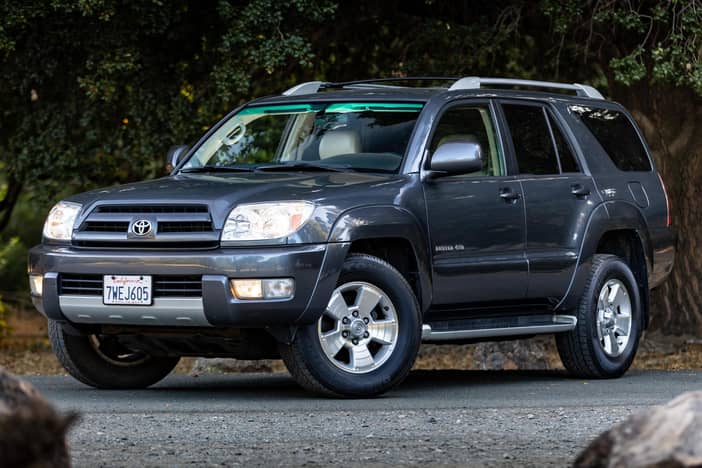
The 2003 Toyota 4Runner is a mid-size SUV that was known for its rugged capabilities, reliable performance, and spacious interior. It was the fourth generation of the 4Runner, and it was produced from 2002 to 2009.
The 2003 Toyota 4Runner is a popular SUV known for its ruggedness and reliability, carrying on the legacy of Toyota’s off-road prowess. Its roots can be traced back to the iconic 1970 Toyota Land Cruiser , which established Toyota’s reputation for building durable and capable vehicles.
The 2003 4Runner inherits that same spirit, offering a blend of comfort and off-road capability that makes it a versatile choice for a variety of driving needs.
Trim Levels
The 2003 Toyota 4Runner was available in several trim levels, each offering a different level of features and amenities.
- SR5:The base trim level, the SR5 came with standard features such as air conditioning, power windows and locks, and a CD player.
- Limited:The Limited trim level added luxury features such as leather upholstery, heated front seats, and a premium sound system.
- Sport:The Sport trim level was geared towards a more sporty driving experience, with features such as 17-inch alloy wheels, a sport-tuned suspension, and a rear spoiler.
- SR5 4WD:This trim level added four-wheel drive capabilities to the SR5.
- Limited 4WD:This trim level added four-wheel drive capabilities to the Limited.
Engine Options
The 2003 Toyota 4Runner was available with two different engine options:
- 4.0L V6:This engine produced 245 horsepower and 282 lb-ft of torque. It was the standard engine for all trim levels.
- 4.7L V8:This engine was only available on the Limited and Sport trim levels and produced 266 horsepower and 315 lb-ft of torque.
Both engines were known for their reliability and durability. The 4.0L V6 provided adequate power for most driving situations, while the 4.7L V8 offered more power and torque for towing or off-roading.
Interior and Exterior Design
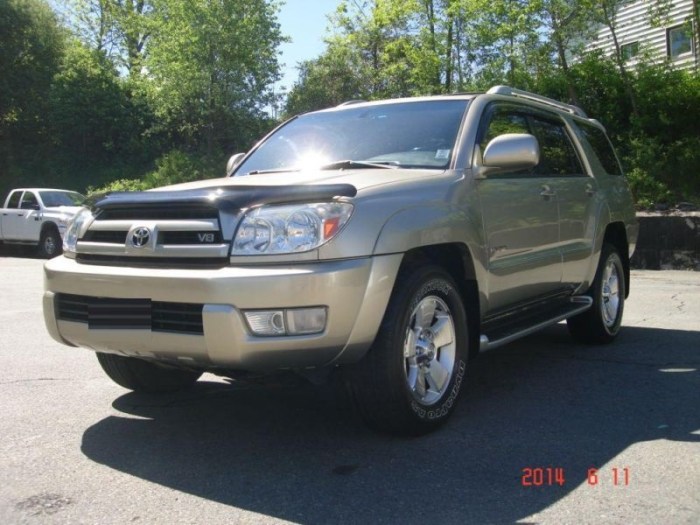
The 2003 Toyota 4Runner boasts a blend of rugged practicality and comfortable amenities, reflecting its positioning as a capable SUV for both on- and off-road adventures. Its interior and exterior design elements contribute to this multifaceted character, appealing to a wide range of drivers seeking a balance of functionality and style.
Interior Design
The 2003 4Runner’s interior was designed with practicality and durability in mind, featuring robust materials and a straightforward layout. The cabin offered ample space for passengers and cargo, making it suitable for families and outdoor enthusiasts. The dashboard was characterized by its simple design and easy-to-use controls.
The instrument cluster provided clear and concise information, while the center console housed essential controls for the HVAC system, audio system, and other functions. The seats were comfortable and supportive, offering a good balance of comfort and practicality. The upholstery was durable and easy to clean, making it suitable for everyday use and outdoor activities.
Exterior Design
The 2003 4Runner’s exterior design exuded a rugged and capable aesthetic, reflecting its off-road prowess. Its boxy shape and high ground clearance provided ample approach and departure angles, enabling it to tackle challenging terrain.The front end featured a bold grille with a prominent Toyota emblem, flanked by large headlights that provided excellent visibility.
The muscular hood and pronounced wheel arches added to the 4Runner’s rugged character.The side profile was characterized by its straight lines and large windows, providing a commanding view of the road ahead. The rear end featured a large tailgate with a swing-out rear window, facilitating easy access to the cargo area.
Comparison to Predecessors and Successors
The 2003 4Runner’s interior and exterior design reflected a significant evolution from its predecessors. Compared to the earlier models, the 2003 4Runner featured a more modern and refined interior with improved materials and ergonomics. The exterior design was also more streamlined and aerodynamic, contributing to a more contemporary look.However, compared to its successors, the 2003 4Runner’s interior and exterior design appeared less sophisticated and modern.
Later models featured more advanced technology, updated styling cues, and more refined interior materials.
Reliability and Durability

The 2003 Toyota 4Runner is renowned for its robust build quality and impressive reliability, making it a popular choice for off-road enthusiasts and families alike. Toyota’s reputation for building dependable vehicles is well-earned, and the 4Runner is no exception.
Common Maintenance and Repair Needs
Understanding the common maintenance and repair needs of the 2003 4Runner can help owners proactively address potential issues and ensure their vehicle remains in top condition.
- Engine:The 4.0L V6 engine is generally reliable, but it’s essential to maintain regular oil changes and ensure the timing belt is replaced at the recommended intervals (90,000 miles or 6 years) to prevent catastrophic engine failure.
- Transmission:The 4-speed automatic transmission is known for its durability, but it’s essential to check the transmission fluid level and condition regularly and ensure it’s serviced at the recommended intervals.
- Suspension:The 4Runner’s suspension components are prone to wear and tear, especially if used for off-roading. Regular inspections and replacements of worn components, such as ball joints, tie rod ends, and control arm bushings, can prevent more significant issues from developing.
- Brakes:The brake system should be inspected regularly for wear and tear. Brake pads and rotors should be replaced as needed to ensure optimal braking performance.
- Electrical System:The electrical system of the 4Runner can be susceptible to issues, especially with age. Common problems include failing window motors, faulty door locks, and intermittent electrical gremlins.
Reliability Compared to Other SUVs
The 2003 Toyota 4Runner consistently ranks highly in reliability surveys, outperforming many other SUVs of the same era.
- Consumer Reports:The 2003 4Runner received a “much better than average” reliability rating from Consumer Reports, surpassing many of its competitors, including the Jeep Grand Cherokee and Ford Explorer.
- J.D. Power:The 4Runner received above-average scores in J.D. Power’s Vehicle Dependability Study for its model year, indicating fewer reported problems compared to other SUVs.
Off-Road Capabilities
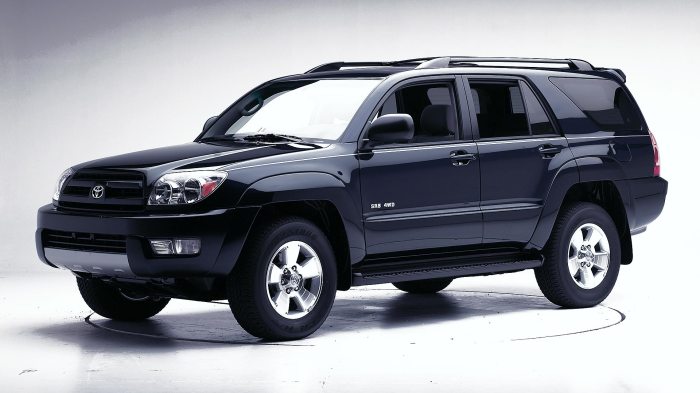
The 2003 Toyota 4Runner was designed with off-road prowess in mind, offering a capable platform for tackling challenging terrain. Its robust construction, high ground clearance, and available off-road features make it a strong contender in the segment.
Standard and Optional Off-Road Features
The 2003 4Runner came standard with features that enhanced its off-road capabilities. These included:
- Part-time four-wheel drive system:This system allows drivers to switch between two-wheel drive for better fuel economy on paved roads and four-wheel drive for improved traction on rough terrain.
- Locking rear differential:This feature distributes power evenly to both rear wheels, providing increased traction in low-grip situations, such as deep snow or loose sand.
- High ground clearance:The 4Runner’s substantial ground clearance allowed it to navigate over obstacles and uneven terrain with ease.
- Solid front and rear axles:These durable axles provided strength and resilience when navigating off-road trails.
In addition to the standard features, optional off-road packages were available, further enhancing the 4Runner’s capabilities. These packages often included:
- Limited-slip rear differential:This system improved traction by sending power to the wheel with the most grip, aiding in situations where one wheel might lose traction.
- Crawl Control:This feature automatically controlled engine speed and braking, allowing drivers to focus on steering while navigating slow, challenging terrain.
- Hill Descent Control:This system assisted in safely descending steep inclines by automatically controlling the vehicle’s speed.
Off-Road Performance Compared to Contemporaries
The 2003 4Runner’s off-road performance was comparable to other contemporary off-road vehicles, such as the Jeep Wrangler and the Nissan Pathfinder.
- Jeep Wrangler:While the Wrangler was known for its extreme off-road capability and articulation, the 4Runner offered a more comfortable and refined on-road experience.
- Nissan Pathfinder:The Pathfinder provided a similar level of off-road capability as the 4Runner, but the 4Runner’s body-on-frame construction offered greater durability and off-road resilience.
Overall, the 2003 4Runner provided a solid combination of off-road capability, on-road comfort, and reliability, making it a popular choice for drivers seeking an adventurous vehicle.
Safety Features
The 2003 Toyota 4Runner was designed with safety in mind, offering a comprehensive suite of standard and optional safety features to protect occupants in the event of an accident.
Standard Safety Features
The 2003 4Runner came standard with a range of safety features, including:
- Anti-lock Braking System (ABS): ABS helps prevent the wheels from locking up during braking, providing better steering control and shorter stopping distances.
- Dual Front Airbags: These airbags deploy in the event of a frontal collision, providing cushioning for the driver and front passenger.
- Side-Impact Door Beams: These reinforced beams in the doors help to protect occupants from side impacts.
- Three-Point Seatbelts: All seating positions were equipped with three-point seatbelts to help secure occupants in their seats.
- Child Safety Locks: Rear door child safety locks were standard, preventing children from opening the rear doors from the inside.
Optional Safety Features
In addition to the standard safety features, the 2003 4Runner offered several optional safety features, including:
- Side Airbags: Side airbags were available as an option, providing additional protection for the driver and front passenger in the event of a side impact.
- Vehicle Stability Control (VSC): VSC helps maintain control of the vehicle during slippery conditions or sudden maneuvers.
- Traction Control (TRAC): TRAC helps prevent wheel spin, providing better traction in slippery conditions.
- Anti-theft System: An anti-theft system was available as an option, providing an extra layer of security for the vehicle.
Safety Ratings
The 2003 Toyota 4Runner received a four-star overall safety rating from the National Highway Traffic Safety Administration (NHTSA), with four stars for frontal impact and five stars for side impact. The Insurance Institute for Highway Safety (IIHS) gave the 2003 4Runner a “Good” rating in the frontal offset crash test and a “Marginal” rating in the side impact test.
Safety Features Compared to Other SUVs
The 2003 4Runner’s safety features were comparable to other SUVs of the same era. Many competitors offered similar standard safety features, such as ABS, dual front airbags, and side-impact door beams. However, the 4Runner’s optional side airbags and VSC system were not as common in other SUVs at the time.
Fuel Economy and Efficiency

The 2003 Toyota 4Runner was known for its ruggedness and off-road capabilities, but its fuel economy was not its strong suit. While it was not the least fuel-efficient SUV of its time, it wasn’t exactly a champion in the fuel economy race either.
Let’s delve into the specifics of the 2003 4Runner’s fuel economy and explore the factors that contributed to its performance.
Fuel Economy Ratings
The 2003 Toyota 4Runner was offered with two engine options: a 4.0-liter V6 and a 4.7-liter V8. The V6 engine, which was the standard option, delivered an estimated fuel economy of 16 mpg city and 20 mpg highway, while the V8 engine achieved 14 mpg city and 18 mpg highway.
These figures were considered relatively average for SUVs of that era, but they fell short of the fuel economy offered by some of its competitors.
The 2003 Toyota 4Runner, known for its ruggedness and off-road capabilities, offers a stark contrast to the sporty and agile 1989 Toyota MR2. While the MR2 was designed for speed and handling on paved roads, the 4Runner excels in conquering challenging terrains.
Both vehicles, however, share Toyota’s reputation for reliability and longevity, making them popular choices for enthusiasts seeking different driving experiences.
Factors Affecting Fuel Economy
Several factors contributed to the 2003 Toyota 4Runner’s fuel economy, including:
- Engine Size and Power:The 4Runner’s V6 and V8 engines, while powerful, were relatively large and thirsty. They required more fuel to generate the necessary power for the vehicle’s size and off-road capabilities.
- Vehicle Weight:The 4Runner was a large and heavy SUV, adding to its fuel consumption. Its robust construction and off-road features contributed to its weight, which impacted its fuel efficiency.
- Aerodynamics:The 4Runner’s boxy design was not particularly aerodynamic, which increased drag and negatively affected fuel economy. A more streamlined shape would have improved its fuel efficiency.
- Driving Habits:Driving habits significantly impacted fuel economy. Aggressive acceleration, frequent braking, and excessive idling all reduced fuel efficiency. Conversely, smooth acceleration, coasting when possible, and minimizing idling improved fuel economy.
Comparison with Other SUVs
In terms of fuel economy, the 2003 Toyota 4Runner’s ratings were comparable to other SUVs of its era. For instance, the Jeep Grand Cherokee with a 4.7-liter V8 engine had a similar fuel economy rating of 14 mpg city and 18 mpg highway.
However, some competitors offered better fuel economy, such as the Honda Pilot with its 3.5-liter V6 engine, which achieved 18 mpg city and 24 mpg highway.
Resale Value and Ownership Costs
The 2003 Toyota 4Runner, known for its ruggedness and reliability, holds its value reasonably well compared to other SUVs of the same era. However, factors like condition, mileage, and trim level significantly impact resale value.
The 2003 Toyota 4Runner, known for its rugged reliability, offered a different approach to off-roading compared to the smaller, more nimble vehicles of its time. While the 4Runner was designed for tackling challenging terrain, its heritage can be traced back to the compact 1990 Toyota Starlet , a model that emphasized fuel efficiency and maneuverability.
Despite their contrasting roles, both vehicles showcased Toyota’s commitment to producing durable and dependable vehicles.
Resale Value Analysis
The 2003 Toyota 4Runner’s resale value is influenced by its reputation for reliability, off-road capability, and overall durability. According to Kelley Blue Book, the average trade-in value for a 2003 4Runner in good condition with around 100,000 miles is between $3,000 and $5,000.
This range can vary based on the specific trim level, options, and overall condition.
Typical Ownership Costs
The 2003 Toyota 4Runner’s ownership costs are generally considered to be moderate, thanks to its reputation for reliability and low maintenance needs.
- Fuel Economy:The 2003 4Runner’s fuel economy is average for its class, with the V6 engine achieving around 16 mpg in the city and 20 mpg on the highway.
- Insurance:Insurance premiums for a 2003 4Runner can vary based on factors like location, driving record, and coverage levels. However, insurance costs are typically in line with other SUVs of the same era.
- Maintenance:Toyota vehicles are generally known for their reliability and low maintenance costs. Regular oil changes, tire rotations, and brake pad replacements are common maintenance items for the 2003 4Runner.
- Repairs:While the 2003 4Runner is known for its reliability, some common repairs might include replacing the timing belt, water pump, or suspension components as the vehicle ages.
Comparison to Other SUVs
Compared to other SUVs from the same era, the 2003 Toyota 4Runner holds its value well. While some competitors, such as the Jeep Grand Cherokee, might have slightly higher resale values, the 4Runner’s reputation for reliability and off-road capability often outweighs those differences.
Advantages and Disadvantages: 2003 Toyota 4Runner
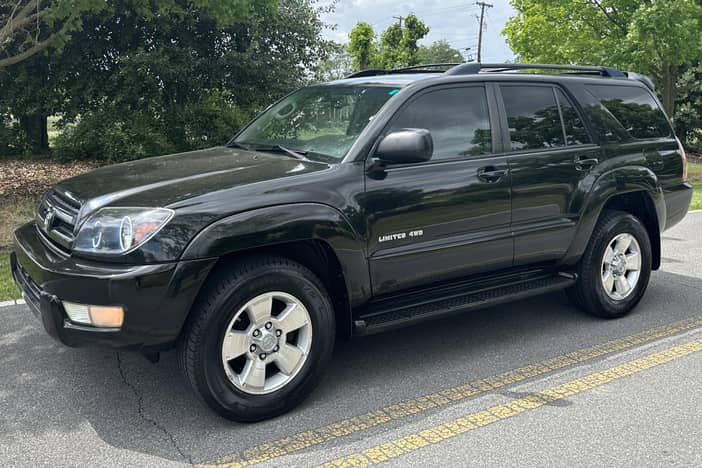
The 2003 Toyota 4Runner is a popular SUV known for its reliability, off-road capability, and spacious interior. However, like any vehicle, it has its own set of advantages and disadvantages.
Advantages and Disadvantages of Owning a 2003 Toyota 4Runner
To help you decide if a 2003 Toyota 4Runner is the right fit for you, here’s a table summarizing its key advantages and disadvantages.
| Feature | Advantage | Disadvantage | Overall |
|---|---|---|---|
| Reliability and Durability |
|
|
The 2003 Toyota 4Runner is generally known for its reliability and durability. However, age and mileage can impact its maintenance needs. |
| Off-Road Capability |
|
|
The 2003 Toyota 4Runner offers solid off-road capabilities, but it’s not a dedicated off-road vehicle and may require modifications for extreme conditions. |
| Interior and Exterior Design |
|
|
The 2003 Toyota 4Runner offers a spacious and functional interior, but its design may feel dated compared to newer models. The exterior is rugged and utilitarian, appealing to those who value practicality. |
| Fuel Economy and Efficiency |
|
|
The 2003 Toyota 4Runner provides sufficient power, but its fuel economy is not exceptional. Consider your driving needs and fuel costs when making your decision. |
| Safety Features |
|
|
While the 2003 Toyota 4Runner offers basic safety features, it lacks the advanced safety technologies found in modern vehicles. Consider this when assessing its safety performance. |
| Resale Value and Ownership Costs |
|
|
The 2003 Toyota 4Runner generally holds its value well, but its resale value will decline over time. Ownership costs may increase as the vehicle ages and requires more maintenance. |
Popular Modifications and Upgrades

The 2003 Toyota 4Runner, a rugged and capable SUV, often becomes a blank canvas for owners who want to personalize their vehicles for better performance, aesthetics, or off-road prowess. The aftermarket industry offers a plethora of parts and accessories that cater to these desires.
Lift Kits and Tires
Lift kits are a popular modification for 4Runners, as they increase ground clearance, enabling better off-road performance and a more aggressive stance. Lift kits come in various heights, from subtle 2-inch lifts to more extreme 6-inch or even higher lifts.
Larger tires, typically in sizes like 33 inches or even 35 inches, are often paired with lift kits to enhance off-road traction and provide a more imposing appearance.
- Benefits:Improved ground clearance for tackling obstacles, better approach and departure angles, improved off-road traction, and a more aggressive appearance.
- Drawbacks:Increased vehicle height can affect handling and stability, potentially reducing fuel efficiency, and may require additional modifications, such as longer suspension components and steering linkage, to compensate for the lift.
Performance Upgrades, 2003 Toyota 4Runner
Enhancing the 4Runner’s performance can be achieved through various modifications, including engine tuning, exhaust upgrades, and cold air intakes. These upgrades aim to increase horsepower, torque, and improve throttle response.
- Benefits:Increased horsepower and torque, improved throttle response, and potentially a more aggressive exhaust note.
- Drawbacks:Some performance upgrades may void the vehicle’s warranty, and modifications may not always be compatible with all factory components.
Off-Road Accessories
For serious off-road enthusiasts, a range of accessories can be added to further enhance the 4Runner’s capabilities.
- Winches:Electric winches provide a powerful tool for pulling the vehicle out of difficult situations or assisting other vehicles.
- Rock Sliders:These protective rails along the sides of the vehicle help to prevent damage to the bodywork when navigating challenging terrain.
- Skid Plates:Skid plates, made from steel or aluminum, protect the undercarriage from rocks and other obstacles.
- Roof Racks:Roof racks provide additional cargo space for camping gear, luggage, or other equipment.
Interior Upgrades
Interior upgrades can enhance comfort, functionality, and aesthetics.
- Seat Covers:Custom-fit seat covers can protect the original upholstery from wear and tear, spills, and dirt.
- Floor Mats:All-weather floor mats help keep the interior clean and protect the carpet from dirt and moisture.
- Dash Kits:Dash kits can give the interior a more modern or sporty look.
Historical Context and Legacy
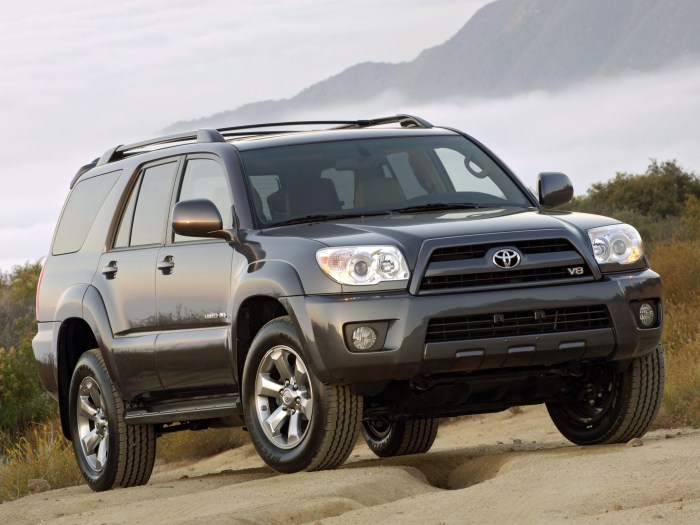
The 2003 Toyota 4Runner was introduced at a time when the SUV market was experiencing a boom, fueled by rising fuel prices and a growing demand for vehicles with greater versatility and off-road capability. This model marked a significant shift for Toyota, as it incorporated several key features and advancements that would shape the future of the 4Runner lineage.
Impact on the SUV Market
The 2003 4Runner’s impact on the SUV market was significant, as it offered a compelling blend of ruggedness, comfort, and reliability that appealed to a wide range of buyers. It was one of the first SUVs to feature a V8 engine option, providing ample power for towing and off-road adventures.
The 4Runner’s reputation for durability and off-road prowess further solidified its position as a formidable competitor in the segment.
Legacy and Influence on Subsequent Generations
The 2003 4Runner’s legacy is evident in the design and features of subsequent generations. Its success paved the way for the introduction of more powerful engine options, advanced safety features, and improved off-road capabilities in later models. The 4Runner’s reputation for reliability and durability has remained consistent throughout its history, making it a highly sought-after vehicle for both on- and off-road use.
Conclusion
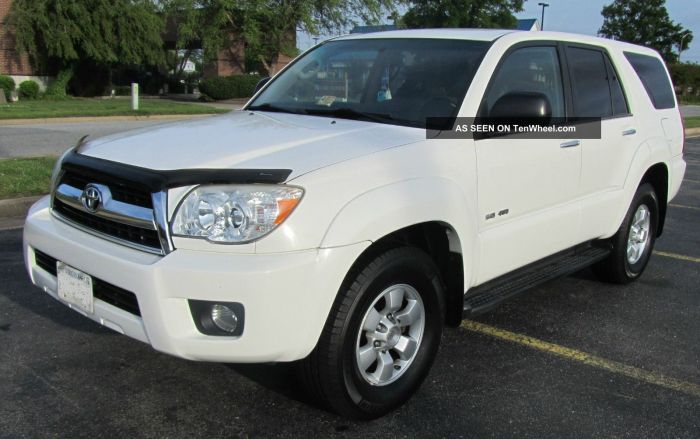
The 2003 Toyota 4Runner stands as a testament to Toyota’s commitment to building durable and reliable vehicles. Its blend of ruggedness, versatility, and timeless design has solidified its place as a popular choice among SUV enthusiasts. Whether you’re considering purchasing a 2003 4Runner or simply curious about its legacy, this guide has provided a comprehensive exploration of its key features and characteristics.
With its reputation for reliability, off-road capability, and enduring appeal, the 2003 4Runner remains a compelling option for those seeking a capable and enduring SUV.